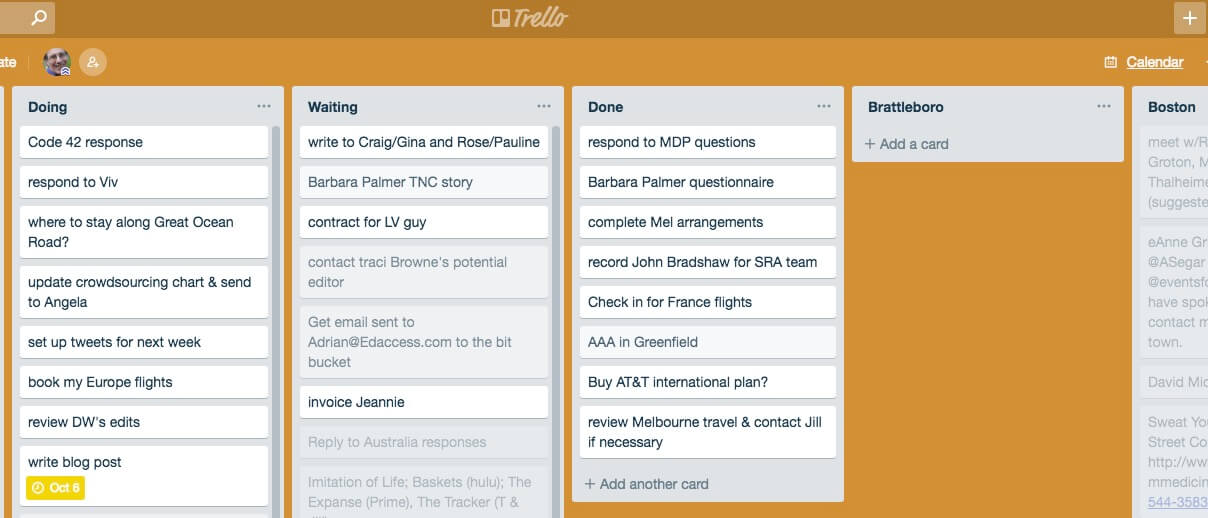Do you have a perfectly organized life? Familiar with Kanban and Getting Things Done? If not, read on!
“The list is the origin of culture. It’s part of the history of art and literature. What does culture want? To make infinity comprehensible. It also wants to create order — not always, but often. And how, as a human being, does one face infinity? How does one attempt to grasp the incomprehensible? Through lists…”
—Umberto Eco, SPIEGEL Interview, 2009
Managing my life
Are you blessed with a perfect memory? Me neither! To avoid unpleasant consequences, everyone like us needs a reliable way to keep track of things we have yet to do. As I age, my memory slowly deteriorates. But my life shows no sign of becoming simpler. There will be entries on my To Do list until the day I die.
Over the years I’ve tried many different methods to implement effective To Do lists and I’m sharing here the system I’ve used successfully for the last 10 years. I hope it will be useful information for anyone like me who has struggled to track and prioritize their personal life and professional work.
Creating a successful To Do list methodology
One of the reasons why it’s hard to track and prioritize To Dos is that we have a tendency to pick an available tool without first deciding what To Do list methodology will work for us. So many tools exist — simple written lists, elaborate day planners, electronic devices, software, apps, etc. Most of them have built into them an implicit methodology as to how we should manage our tasks. Unfortunately, one person’s methodological meat may be another’s poison.
After much experimentation, I have settled on using a combination of Kanban and Getting Things Done methodologies to capture and prioritize my life tasks.
Kanban was originally developed in the 1940s to schedule just-in-time manufacturing. In the 2000s Kanban was adapted to manage and communicate software development. Recently, Personal Kanban has become popular, and I’ve been using a modified version since 2014.
The simple yet brilliant Getting Things Done (GTD) methodology doesn’t prescribe a complete system for organizing your life. Instead, it encapsulates only the essential workflow processes you need to follow to clear and organize your work life, plus what you need to know in order to choose tools and procedures that work for you. Each person’s implementation of GTD is unique.
Kanban and GTD — a winning combination!
The essence of Personal Kanban is the creation and continual updating of three lists: To Do, Doing, and Done. Tasks migrate from To Do –> Doing –> Done as we work. Most practical implementations (including mine) add a Waiting For list, to capture top-of-mind tasks that currently require action outside our control before working on them.
To these core lists, GTD suggests adding separate lists for each set of project tasks. So I have a Brattleboro list (things to do when I go into town). A Boston list (when I am at our apartment there). And a Book 3 list (for tasks remaining before I publish my next book) and lists for current client projects. I move tasks from these lists into and between the core Kanban lists through the review process.

Implementation
Trello is a superb tool for implementing Kanban/GTD; check here for more information on how I use it. When I’m occasionally deviceless (yes, it still happens in this oh-so-connected world) I rely on good old paper and pen to capture ideas and build short in-the-moment To Do lists, e.g. shopping lists. My manpurse holds a Levenger Pocket Briefcase, always filled with 3 x 5 cards, a Reporter’s Notebook, plus a variety of reliable pens, ensuring I can always fall back on a two-thousand-year-old method of making lists.
Conclusion
Amazing methodologies and technologies are available to us. Effectively planning and managing a complicated life can be easier and less stressful if you adopt approaches like Kanban/GTD and adapt them to work well for you. The choice is yours!
